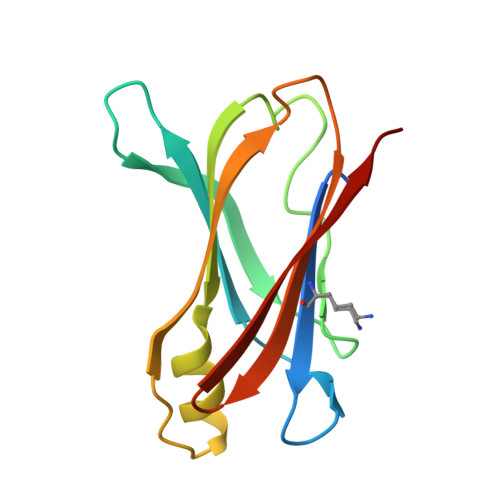A Fluorogenic Aryl Fluorosulfate for Intraorganellar Transthyretin Imaging in Living Cells and in Caenorhabditis elegans.
Baranczak, A., Liu, Y., Connelly, S., Du, W.G., Greiner, E.R., Genereux, J.C., Wiseman, R.L., Eisele, Y.S., Bradbury, N.C., Dong, J., Noodleman, L., Sharpless, K.B., Wilson, I.A., Encalada, S.E., Kelly, J.W.(2015) J Am Chem Soc 137: 7404-7414
- PubMed: 26051248
- DOI: https://doi.org/10.1021/jacs.5b03042
- Primary Citation of Related Structures:
4YDM, 4YDN - PubMed Abstract:
Fluorogenic probes, due to their often greater spatial and temporal sensitivity in comparison to permanently fluorescent small molecules, represent powerful tools to study protein localization and function in the context of living systems. Herein, we report fluorogenic probe 4, a 1,3,4-oxadiazole designed to bind selectively to transthyretin (TTR). Probe 4 comprises a fluorosulfate group not previously used in an environment-sensitive fluorophore. The fluorosulfate functional group does not react covalently with TTR on the time scale required for cellular imaging, but does red shift the emission maximum of probe 4 in comparison to its nonfluorosulfated analogue. We demonstrate that probe 4 is dark in aqueous buffers, whereas the TTR·4 complex exhibits a fluorescence emission maximum at 481 nm. The addition of probe 4 to living HEK293T cells allows efficient binding to and imaging of exogenous TTR within intracellular organelles, including the mitochondria and the endoplasmic reticulum. Furthermore, live Caenorhabditis elegans expressing human TTR transgenically and treated with probe 4 display TTR·4 fluorescence in macrophage-like coelomocytes. An analogue of fluorosulfate probe 4 does react selectively with TTR without labeling the remainder of the cellular proteome. Studies on this analogue suggest that certain aryl fluorosulfates, due to their cell and organelle permeability and activatable reactivity, could be considered for the development of protein-selective covalent probes.
- †Department of Chemistry, ‡Department of Molecular and Experimental Medicine, §Department of Integrative Structural and Computational Biology, ∥Department of Chemical Physiology, ⊥Department of Molecular and Cellular Neuroscience, #The Skaggs Institute for Chemical Biology, ∇Dorris Neuroscience Center, The Scripps Research Institute, 10550 North Torrey Pines Road, La Jolla, United States.
Organizational Affiliation:



















